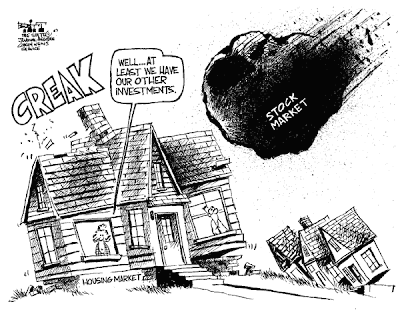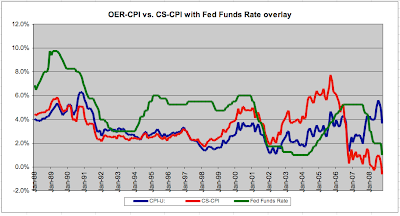Here’s an important economic analysis by Mish, looking at housing prices, interest rates, inflation and deflation, and also sharing his thoughts and expectations.
Note: The Case-Shiller Home Price Indices are quarterly nominal house price indices for the United States. The Consumer Price Index (CPI) is a measure of the average change in prices over time of goods and services purchased by households. CPI-U is the Consumer Price Index for All Urban Consumers.
Case Shiller CPI vs. CPI-U November 2008 Analysis
Courtesy of Mish
This post is an update on the Case-Shiller-CPI (CS-CPI).
The chart is courtesy of my friend "TC" and a brief explanation is that the Case-Chiller housing index is substituted for Owners’ Equivalent Rent in the CPI. The results are compared to the BLS Government Published CPI (CPI-U called OER-CPI in the following chart).
CS-CPI vs. CPI-U
click on chart for sharper image.
The chart shows the negative consumer prices as measured by CS-CPI. Those watching the CS-CPI have not been shocked by the dramatic plunge in long term interest rates. Those woodenly following CPI-U preaching about negative real interest rates have been barking up the wrong tree.
In spite of massive cuts in the Fed Funds Rate, real interest rates are still positive by more than 1% and will still be positive when Bernanke cuts 50 to 75 basis points on December 16. Looking ahead I expect both falling consumer prices and falling home prices yet Bernanke is running out of room to cut rates.
Going forward, time permitting from "TC" who produces this chart, I will publish the data shortly after the release of Case Shiller housing data towards the end of every month and/or after the BLS CPI Release.
Please see Case Shiller and CAR November 2008 Release for the latest Case Shiller and California Association of Realtors data analysis by "TC".
Methodology Background
"Owners’ Equivalent Rent" (OER) is the largest component in the government compilation of the CPI. OER is a process in which the BEA estimates what it would cost if owners were to rent the homes they own from themselves. I do not believe this to be a valid construct of prices.
By ignoring housing prices, CPI massively understated inflation for years. The CPI is massively overstating inflation now.
In normal times with rents in sync with home prices, it did not matter much if one used OER or actual home prices. It’s a remarkably different story now. We have just seen the biggest housing bubble in the history of the world. At the peak of insanity, home prices were 3 standard deviations above rental prices and 3 standard deviation above wage growth.
Now, the important factor is that home prices are crashing, with quite a big drop still needed to get back to historic norms. With that in mind, housing can be expected to be weak for quite some times.
The treasury market seems to have figured all this out quite nicely. Pundits screaming "treasury bubble" clearly have not.
In summer of 2005 the above chart shows the CPI at just over 4% with the Fed Funds Rate just under 4%. CS-CPI, a better measure of the CPI, was near a whopping 8%. Thus real interest rates were stunningly low starting in 2003. The Fed kept interest rates too low for two years. This clearly contributed to the housing bubble.
The Situation reversed in Autumn of 2006 with the Fed Funds rate at 5.25% and CS-CPI under 1%. This helped pop the bubble (a good thing) but it would have been better to not have the bubble in the first place.
Other sites have independently come up with same idea behind CS-CPI, notably the The Mess That Greenspan Made. There are likely to be others. I thought of the idea years ago but never charted it, and in fact seldom chart anything myself, with thanks to Bart at Now and Futures, Nick at Sharelynx Gold, and now "TC", all of whom have better charting skills than I do.
Real Interest Rates Are Positive
Many complain that the Fed is extremely loose right now. While not a fan of 1% interest rates per se, based on the above chart I disagree. The chart shows CS-CPI is close to zero with the Fed Funds rate at 1%. Furthermore, I expect the CPI (not just the CS-CPI) to crash given what is happening with energy and transportation prices.
Notes From "TC"
1. The "relative importance" or weight of OER has changed over time – it was 19.10 in 1987 and is now 23.942. I’ve included the yearly weight within the data.
2. The Case-Shiller National Index is only released quarterly and the 20 city composites represent sales are a couple months old while the CPI reflects the previous month.
Do home prices belong in the basket?
I have had many people over past year tell me they do not care about home prices because they rent, or tell me that do not care about home prices because they own their home outright, or tell me they do not care about home prices because their house is a long term investment.
People may not care (or more realistically they may think they do not care), but the treasury market sure cares about something, and the most likely something is the destruction of wealth in housing along with the ramifications the housing market has on bank credit, corporate earnings, consumer attitudes, etc.
It’s true that a person does not buy a home every week but that same person does buy food and gasoline every week. However, that does not make the price decline any less real. More importantly, it is naive to think treasuries should ignore the ongoing destruction of wealth in housing and the bank writeoffs that bust is causing.
Let’s look at this from a practical standpoint. What’s more important, home prices dropping $50,000 to $250,000 in value over the course of a few years or the price of gasoline going from $2.00 a gallon to $4.00 a gallon over the course of those same few years?
From a macro-economic standpoint, the correct answer to the above question is housing even though consumers were constantly griping about gasoline prices until the recent selloff. The easily seen is gasoline price hikes because people buy it every week. Practically speaking, the destruction of housing wealth matters far more. Here is the question to ask: How many tanks of gas will it take to equal the loss of $50,000 on a house?
On this basis, the so-called "irrational behavior" of the long bond specifically, and the entire treasury curve in general, does not seem so irrational.
Is there Justification For This Methodology?
For the record, I do not think it is possible to easily define and measure the prices of a representative basket of goods and services. However, CS-CPI makes more sense than the widely used CPI basket. It at least explains the so-called "irrational bond market" and also "Greenspan’s Conundrum". I argue the treasury market could see the deflationary credit bust coming that Greenspan helped create.
Thus while one can dismiss the theory, I counter that it explains what happened in practice, and that is what matters. From a practical standpoint alone, housing is a consumption item requiring continual maintenance, not a bond one can hold to maturity and forget about. Also from a practical standpoint, CS-CPI properly accounts for home ownership instead of attempting to figure out how much rent one would pay renting a house from oneself.
Finally, the CS-CPI clearly show that the Fed overshot in both directions by misinterpreting or just plain ignoring the data that it had. This is further proof that it is time to abolish the Fed and let the market set rates.



